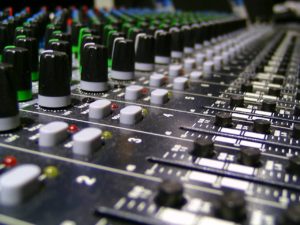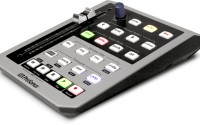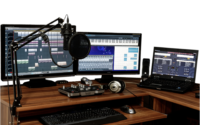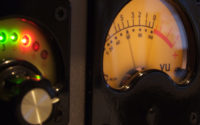Recording With Intent
We live in a world of near-infinite track counts. It’s all too easy to record 16 vocal harmonies, 32 guitar tracks, and 50 different synth sounds. Maybe you’ve read an article or heard an interview from some A-listers, be they musicians, producers, or engineers. Often, they’ll mention a project they recently worked on, and they might mention that there were over 100 tracks in the session that they had to mix down to a 2-track stereo file for the masses to listen. I myself have even been guilty of recording some over-the-top sessions, as far as track count.
The “Too-Big Session” Recording Story
A few years ago, I was recording a track for a buddy of mine who was visiting from Los Angeles. We started with just guide tracks: an acoustic guitar and a rough vocal, and produced the track around that. We started adding electric guitars here, organs there, strings over here, at least four bass tracks. The idea was to make this song sound larger-than-life. If memory serves, we ended up with about 80 tracks in the session – all in the name of, “well, let’s just add some more until it’s big enough!!” We didn’t exactly have an end-goal in mind. It seemed like the reason we did anything was, “because we can.”
Before we’d even EQ’d anything, I could tell it was going to be a bit of a mess, but in my head, I just thought, “If I can find what the main focuses are for this track, and carve everything else around that, we’ll be in good shape.”
I normally take anywhere from 2 to 12 hours to mix a song, depending on the song, the style, and any number of factors.
This one took a week to wrangle into shape.
But I finally got it in a workable spot and sent it off. I was exceptionally proud of it. I told my buddy to sit with the song for a few days, take notes, and listen to it on a lot of different systems.
He came back and told me to mute half of the tracks.
Half.
We talked over the phone and discussed what to mute and where, and ultimately brought the song down to around 35 tracks. A much more manageable number.
The really cool part came when I remixed it – since half of the tracks were gone, I no longer needed to make insane EQ moves to get everything to poke out where it needed to. Each track had a little more room to spread out, since there was less competition between sounds. Ultimately, the mix with fewer tracks sounded bigger.

Intent Is Key
That day was a great lesson for me, one I take with me to each new session, whether I’m recording my own music, or working with someone else.
Before I even set up a mic or arm a track, I decide exactly what I’m going to record, and how it’s going to contribute to the song as a whole. I don’t add synths or layer more guitars onto a song just for the sake of it (with the exception of the ukulele I just tossed onto one of the tracks of my upcoming album). If I’m recording an acoustic guitar, I know before I even tune it up whether it’s going to be a focal point for the song, or if I’m using the strumming sound as more of a rhythmic texture that’s going to be panned off to one side.
I know before I play that organ part, whether it’s a solo to be up front, or a melodic piece behind something else like a guitar solo or lead vocal.
If you jump in with “this song needs a piano part,” know what purpose that piano part is playing.
I’m not saying you need to keep things exceedingly minimal. I’m saying make sure everything you’re doing serves the song, and isn’t just there for the sake of being there.







